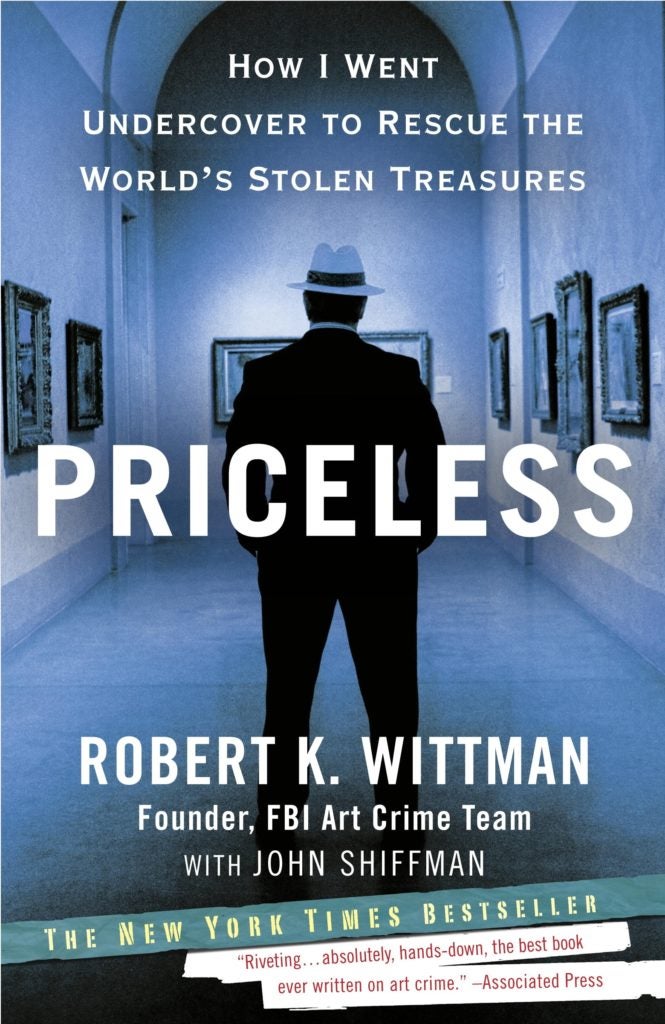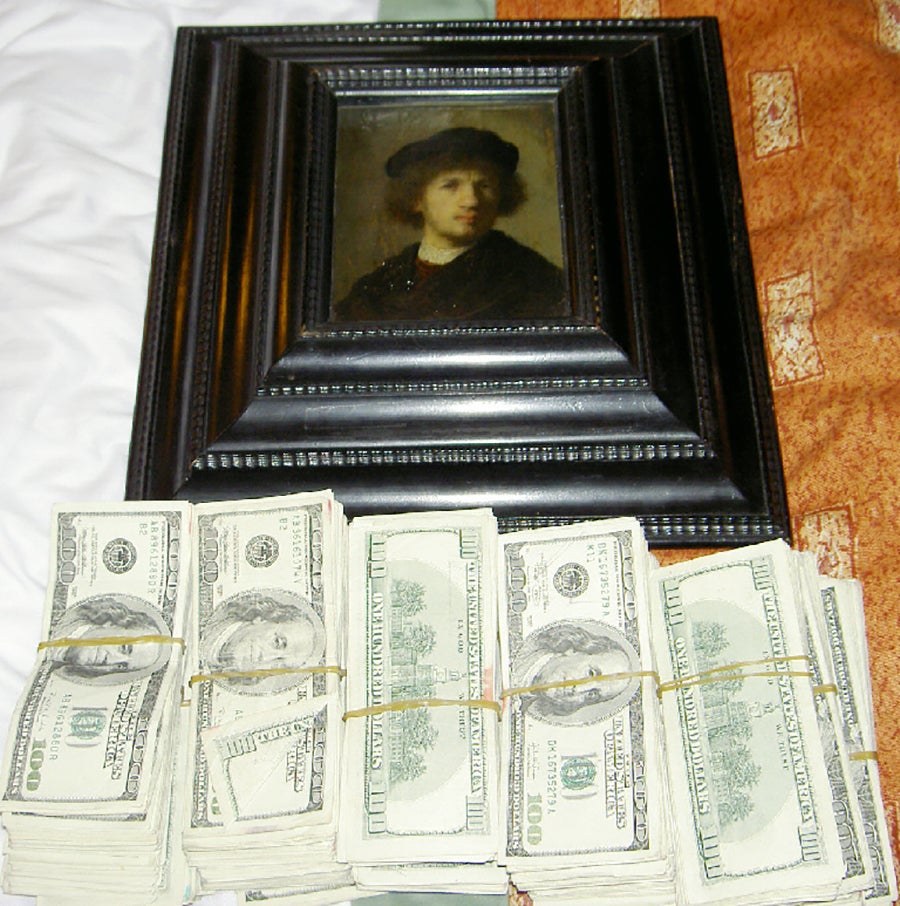Do you know why the “Mona Lisa” is the most famous painting in the world? It’s not the mystery of her smile. It’s not the fact that it was painted by Leonardo da Vinci. What transformed the painting, originally titled “La Gioconda,” into the most-recognized artwork in the world were the two years when it was stolen. In absence, it became priceless.
It was in the early morning hours of August 21, 1911, when three Italian laborers in overalls emerged from a storage closet where they’d spent the night in hiding. Since it was a Monday, the Louvre was closed. Two of the thieves were brothers — Michele and Vincenzo Lancellotti. The third man, Vincenzo Peruggia, was the brains of their operation. He’d designed and installed the protective glass that housed the masterpiece. Their art heist was an inside job.
After they separated the painting from its protective glass case, they wrapped it in a sheet, and then casually exited the museum. An early morning workman even held the door open for Peruggia as he carried out the stolen masterpiece. At the Quai d’Orsay train station, the thieves hopped on the 7:47 a.m. train and fled Paris. The execution of their heist had been flawless.
For 28 months, the “Mona Lisa” remained missing, its legend growing immeasurably in the process. Throughout Paris, postcards, etchings and prints of the painting were sold to tourists. Meanwhile, the blank spot in the museum where the masterpiece was once displayed spoke to the soul of France, a reminder of what they valued. Even Kafka came by to see the artwork’s absence.
The French police never caught the men who stole the painting. But the mastermind, Peruggia, did eventually come out of hiding. While lying low in Florence, he tried to sell the painting to an Italian dealer. The dealer asked if the head of a museum in Florence could appraise and authenticate the masterpiece. He inspected it and found a stamp that confirmed the painting was authentic. The art dealer and the head of the museum lied to Peruggia, promising him a reward. He left satisfied. Thirty minutes later, the police rolled up to his spot and arrested him. Peruggia was charged, tried, convicted and sentenced to eight months — a light sentence. What mattered most was that he’d made the “Mona Lisa” priceless.
Today, the world of international art crime is a multibillion dollar criminal enterprise. In 2014, Newsweek reported, “After Drugs and Guns, Art Theft Is the Biggest Criminal Enterprise in the World.” The article outlines the scope and magnitude of modern art crime: “Worldwide, some 50,000 to 100,000 works of art are stolen each year. Not surprisingly, only about 10 percent of stolen art is recovered, and successful prosecution occurs even less frequently.”
But can this possibly be true? Is there actually a lawless criminal underworld thriving in the shadows and art black markets all around the world? Does this multibillion-dollar criminal enterprise rank third, only behind guns and drugs? Can stolen art really be the world’s third largest vice?
To track down some answers, I spoke with Robert Wittman, the former head of the FBI’s Art Crimes Department. The 30-year veteran investigator now works as a private investigator, expert witness, public speaker, educator and writer. Author of the book Priceless: How I Went Undercover to Rescue the World’s Stolen Treasures, Wittman writes candidly about what really goes down in an FBI operation to recover stolen artwork. For example, he once bought a $35 million masterpiece while pretending to be an appraiser working for the Russian mob. There was another time when he found the only missing version of the original Bill of Rights. All in all, it’s taught him as much about the true value of things as it has art, crime and greed combined.

There’s a commonly cited statistic that art crime is “the third most lucrative criminal enterprise in the world,” trailing only drugs and guns. Is that accurate?
No. [Laughs] No, it is not.
Why does this false stat constantly get repeated in stories about art crime?
Maybe it was true at some point. Today, I think art crime is around the sixth-largest criminal enterprise, according to FBI and Interpol. The biggest right now is money-laundering, then gun-running, drugs and human slavery. Those are all larger organized criminal enterprises. Art crime comes in at about fifth or sixth.
How did the FBI come up with their estimate of $6 billion?
Well, half the statistics I made up. [Laughs] Seriously! The New York Times wanted to know how big art crime is in the world. FBI headquarters called me, and I said, “Eh, it’s about $6 billion.” [Laughs] That was originally my quote. The New York Times picked it up, and it’s all over the world now. They attributed it to the FBI. But the truth is: Nobody knows. It could be $10 billion. There’s no statistical analysis done by specific police departments since it’s part of the Property Crimes Department statistics. There are no separate art crimes statistics. I know, I was the head of the FBI’s Art Crimes Department. [Laughs]
I did some research at the FBI to see how much was stolen over the last 10 years. I spoke to my counterparts at Interpol and the Antiques Squad at Scotland Yard and at the Metropolitan Police of London. We got our heads together and came up with some figures. My estimate at the time was, and still is, about $6 billion.
In the world of art crime, what grabs headlines are museum robberies, the ongoing hunt for artwork looted by the Nazis, stolen and counterfeited Chinese antiques and Middle Eastern antiquities. Do the headlines provide an accurate picture?
The megatrends are frauds, forgeries and fakes. But yes, stuff still gets stolen all the time. Burglars break into houses and steal art. A $2,000 print, a $5,000 sculpture, those sorts of things go under the radar, but they can be sold in secondary markets, flea markets, antique shops and antique shows. There’s no way to track them. Now, when we talk about million-dollar artifacts and paintings, known to the public, those pieces are tracked through their provenance. Those things can’t be sold, not easily. When you talk about large art crimes, the true talent isn’t in the art heist, it’s in the selling: How do you monetize that object?
So the popular image of sophisticated art thieves, that’s mostly a Hollywood fiction?
Yeah, that’s Hollywood. [Laughs]
Like the Bond villain Dr. No. The spy series capitalized on the theft of a famous Goya painting from the National Gallery in 1961. The filmmakers featured this stolen masterpiece prominently in Dr. No’s secret lair as if he’d stolen it and he was this powerfully rich man driven to possess timeless beauty. Do you ever come across such men in reality?
The whole Bond villain thing from Dr. No — that was the beginning of this idea that there’s some very rich, nefarious collector, one who’s sitting there lovingly looking at his stolen Picasso in the basement. After 30 years of doing these investigations, I’ve never run into that.
Yet it seems like people do want to own a piece of genius. I mean, isn’t Picasso’s work the most faked and stolen?
I don’t know if he’s the “most faked,” but he’s the “most stolen.” The reason is threefold. One, he has the big name — everyone knows Picasso. Two, there’s an assumption that Picasso paintings hold value. But the main reason is he was so prolific. In 1968 alone, he did a series of etchings and lithographs called the 347 Series. The series was 347 artworks he did over the course of nine months. Each of them and the prep was published 50 times. So if you do the math, in 1968, he generated 18,000 prints that were valuable. He did another series in 1970. I think there’s 10,000 Picasso pieces that are considered taken or stolen at the moment. That’s a small percentage of his actual output. Now, if you take a guy like Vermeer, who only has 35 known paintings, to have one of his stolen is a big deal.
What about the high-dollar robberies, like cat burglars who use elaborate methods to steal expensive art objects? Does that actually happen, or is that purely Hollywood, too?
We had a case involving a group of individuals that walked into the Swedish National Museum, at 5 o’clock, two days before Christmas. They had machine guns. They made everybody lie down on the floor. They set off car bombs in the city to stop the police from responding. They made their getaway with a high-speed boat they’d parked in the harbor, next to the museum. So well thought-out robberies do still happen. There are still real criminal enterprises run by professional criminals who execute complex crimes for a living. As far as cat burglars are concerned, they still exist, too. They’re not usually stealing artwork, though; they’re usually out to steal money and jewelry.
Working undercover and dealing with sources ranging from Russian gangsters to New York art dealers to Brazilian ex-cons, are you quickly able to read other people?
Of course. The ability to create a relationship with another person is the most important part of any type of undercover operation. We used to say you have to be friends to betray.
What’s your angle to befriending somebody you expect to betray?
It’s offering them something they need, something of value to them. Most thieves who get involved in art theft aren’t good businessmen. As a result, they create a situation where they have this stolen artwork but they don’t know how to monetize it. So you go in as the person who can commoditize that situation for them. My most successful undercover operations where as a shady dealer who had clients interested in buying stolen art. The thing that motivates everybody is hope. It doesn’t matter if you’re a criminal or not, everyone hopes. These individuals who steal art, they hope to monetize it. If you can provide a small inkling of that hope, you can leverage the desire of just one person and infiltrate the group.
Are you a fan of art, or was it more about justice?
For every investigator there’s a certain amount of desire to solve the crime. That said, it was important to me to recover the stolen art in good condition more than it was to arrest, convict or anything like that. If you steal a Rembrandt from a museum, it’s 400 years old, and yes, at some point, theft of that painting will become part of the history of the piece, but it’s more important to get it back before it’s destroyed or lost to humanity. That would be the real crime.

You’ve had some really storied recoveries in your career. In fact, you once recovered one of the original 14 copies of the Bill of Rights.
That was an undercover operation out of Philadelphia — working out of a very nice white-shoe law firm. The Bill of Rights was stolen in 1865 by a Union trooper who was coming back north with Sherman’s troops from Atlanta. They stopped at Raleigh, the capital of North Carolina. They went into the state house and basically ransacked it. This one trooper from Indiana stole the Bill of Rights. It was the original one that was sent to North Carolina in 1789. And he just took it back home to Indiana. Later, he sold it for $5. [Laughs]
The Bill of Rights stayed in that family until 2003. It came to our attention when it was offered for sale to the National Constitution Center in Philadelphia by one of the appraisers from Antiques Roadshow. Interestingly enough, over the years, I had at least four cases focused on different appraisers from Antiques Roadshow. [Laughs] To get back the Bill of Rights, we performed an end-point recovery. It was being offered for $4 million. The only piece of U.S. history worth more is the Declaration of Independence. There’s only one of those. With the Bill of Rights there are 14 of them, but each is appraised at $100 million. That’s the most valuable piece I ever recovered.

Did you get to hold the document?
Yes, it’s about four feet high, and it’s on cowhide vellum. It was written in black ball ink, by hand. It’s a very interesting piece to be able to look at it.
I’m assuming you’ve seen Nicolas Cage in National Treasure.
That movie was made and came out after we recovered the Bill of Rights. And some of the aspects of it really occurred in our case. I think they adapted some of it.
Back to Antiques Roadshow — is that a good way for the FBI to follow trends in the art world? Or are the prices reflected on the show not accurate?
I’m sure it’s fairly accurate — what’s being shown and what people are told about what they have. As far as that show, our cases with some of the dealers who appeared on it involved frauds and situations outside of the show. What they’d do is use the show for their bona fides. They’d advertise the fact, “We’re on Antiques Roadshow.” That makes people believe they’re legitimate, and they do everything in a forthright manner. They use appearances on that show as a calling card to commit fraud.
When you were working in the field, you often faced far more dangerous subjects than million-dollar antique grifters from PBS. You once, for example, infiltrated an international criminal gang to recover a self-portrait by Rembrandt. Did the nation of Sweden ask you to help out, or did the FBI come across a lead and then you called your Swedish counterparts and said, “Hey, we think we can help you find your missing painting?”
The lead came out of L.A. There was a drug dealer in L.A. who had one of the three paintings that were stolen by a gang of machine-gun-carrying art thieves back in 2000. There were two Renoirs and a Rembrandt stolen. This L.A. drug dealer had access to one of the Renoirs. We were able to recover that painting through a drug investigation in 2005.
As a result of that recovery, we were able to get that individual to flip for us. He introduced us to the gang in Sweden. They still had the Rembrandt. It was the most valuable piece, worth $35 million. We started an undercover operation in Copenhagen. I posed as an authenticator for the Russian mob. We were able to recover that piece after we offered the gang $250,000 in cash for the Rembrandt.
When you’re pretending to be an authenticator from the Russian mafia, if your cover gets blown as an investigator…
Any time you do undercover work, there’s always the risk of being found out. That’s the risk you take. Sometimes it’s a dangerous situation where you could be hurt or killed. The one thing I always did in the morning on the day we were going to do heavy operations is call my wife. I’d just say hello and talk to her about whatever’s going on at home. That settled me down. It reminded me that there’s a bigger life out there than what I was doing. The most important thing was to get home safe.
Was your wife impressed by your bravery?
Mostly she made sure I paid my life insurance bills. [Laughs] That was really important to her. She’s the one who held the family together, took care of the kids, took care of everyone while I was out doing my nonsense. She was really the hero.
Overall, what have you learned most from a life spent saving art and cultural history?
I never really thought much about the intrinsic value of something before the FBI. Not the financial value, but the intrinsic value of a cultural property. Like, I recovered that $35 million Rembrandt stolen in Sweden, but I also recovered a Civil War battle flag. It was carried into battle by one of the first African-American army troops at the Battle of Port Hudson in Louisiana. During that battle, five or six different flag-bearers were shot out from under that battle flag. Each one carried it until they were killed. That was the first time a group of African-American soldiers could fight for their freedom and the freedom of their children, forever. Y’know?
That battle flag was only being sold for $35,000. What’s the difference in the value? One’s $35 million, the other is $35,000. They’re equally priceless. Does that make sense? That was a realization to me: The financial value of something pales in comparison to the intrinsic value of our shared cultural property.

